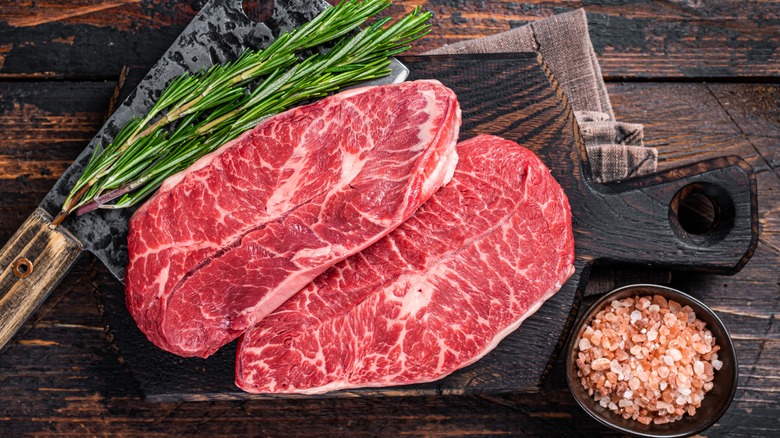The Chewy Reason You Should Avoid Grilling Top Blade Steak
Steak cuts come in a range of shapes and sizes. While all share the potential of a delicious beefy bite, not all necessitate the same preparation. Take grilling, the perfect application for marbled steaks like porterhouse and ribe-eye. While a dependable go-to for many other cuts, such a cooking method isn't suitable for steaks like top blade. The meat will turn out unpalatably chewy, ruining the steak.
It's all due to the cut's origin. The top blade hails from the chuck region, a section of the cow often used in stews. Sliced from a tender muscle in the area — shared with flat iron steaks — it contains a strip of cartilage. A tasty standalone steak can still be crafted but requires particular methods. So, to best showcase the cut, turn to braising or marinating rather than direct grilling. With extra liquid introduced, you can achieve a flavorful and tender steak. Let's dive into the details of how to make the top blade shine.
Manage top blade's cartilage with tender cooking methods
Top blade's misalignment with high heat stems from a strip of cartilage running through the steak. When seared, the connective tissue compresses, yielding unpalatable rubberiness. It's possible to cut out this section — when sliced in the other orientation without the cartilage, the cut becomes a flat iron steak. Although from the same region, the flat iron is delicious when grilled. However, it's not always possible to butcher the top blade into steak-like chunks, so consider preparing strips for a stir fry instead.
If keen to keep the top blade cut intact, a cooking liquid does the trick. The cut is delicious when braised; simply sear first, then simmer in wine, water, or broth for up to an hour and a half. A tender and rich top blade will result. Or, if getting the steak onto a hot heat source is unavoidable, throw the meat into a marinade. It won't create melt-in-your-mouth tenderness but it can still yield a top blade with a tasty character.

